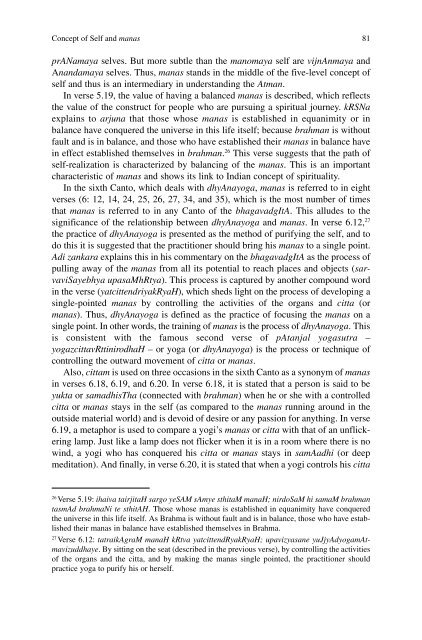Spirituality and Indian Psychology: Lessons from ... - Mandhata Global
Spirituality and Indian Psychology: Lessons from ... - Mandhata Global
Spirituality and Indian Psychology: Lessons from ... - Mandhata Global
You also want an ePaper? Increase the reach of your titles
YUMPU automatically turns print PDFs into web optimized ePapers that Google loves.
Concept of Self <strong>and</strong> manas<br />
prANamaya selves. But more subtle than the manomaya self are vijnAnmaya <strong>and</strong><br />
An<strong>and</strong>amaya selves. Thus, manas st<strong>and</strong>s in the middle of the five-level concept of<br />
self <strong>and</strong> thus is an intermediary in underst<strong>and</strong>ing the Atman.<br />
In verse 5.19, the value of having a balanced manas is described, which reflects<br />
the value of the construct for people who are pursuing a spiritual journey. kRSNa<br />
explains to arjuna that those whose manas is established in equanimity or in<br />
balance have conquered the universe in this life itself; because brahman is without<br />
fault <strong>and</strong> is in balance, <strong>and</strong> those who have established their manas in balance have<br />
in effect established themselves in brahman. 26 This verse suggests that the path of<br />
self-realization is characterized by balancing of the manas. This is an important<br />
characteristic of manas <strong>and</strong> shows its link to <strong>Indian</strong> concept of spirituality.<br />
In the sixth Canto, which deals with dhyAnayoga, manas is referred to in eight<br />
verses (6: 12, 14, 24, 25, 26, 27, 34, <strong>and</strong> 35), which is the most number of times<br />
that manas is referred to in any Canto of the bhagavadgItA. This alludes to the<br />
significance of the relationship between dhyAnayoga <strong>and</strong> manas. In verse 6.12, 27<br />
the practice of dhyAnayoga is presented as the method of purifying the self, <strong>and</strong> to<br />
do this it is suggested that the practitioner should bring his manas to a single point.<br />
Adi zankara explains this in his commentary on the bhagavadgItA as the process of<br />
pulling away of the manas <strong>from</strong> all its potential to reach places <strong>and</strong> objects (sarvaviSayebhya<br />
upasaMhRtya). This process is captured by another compound word<br />
in the verse (yatcittendriyakRyaH), which sheds light on the process of developing a<br />
single-pointed manas by controlling the activities of the organs <strong>and</strong> citta (or<br />
manas). Thus, dhyAnayoga is defined as the practice of focusing the manas on a<br />
single point. In other words, the training of manas is the process of dhyAnayoga. This<br />
is consistent with the famous second verse of pAtanjal yogasutra –<br />
yogazcittavRttinirodhaH – or yoga (or dhyAnayoga) is the process or technique of<br />
controlling the outward movement of citta or manas.<br />
Also, cittam is used on three occasions in the sixth Canto as a synonym of manas<br />
in verses 6.18, 6.19, <strong>and</strong> 6.20. In verse 6.18, it is stated that a person is said to be<br />
yukta or samadhisTha (connected with brahman) when he or she with a controlled<br />
citta or manas stays in the self (as compared to the manas running around in the<br />
outside material world) <strong>and</strong> is devoid of desire or any passion for anything. In verse<br />
6.19, a metaphor is used to compare a yogi’s manas or citta with that of an unflickering<br />
lamp. Just like a lamp does not flicker when it is in a room where there is no<br />
wind, a yogi who has conquered his citta or manas stays in samAadhi (or deep<br />
meditation). And finally, in verse 6.20, it is stated that when a yogi controls his citta<br />
26 Verse 5.19: ihaiva tairjitaH sargo yeSAM sAmye sthitaM manaH; nirdoSaM hi samaM brahman<br />
tasmAd brahmaNi te sthitAH. Those whose manas is established in equanimity have conquered<br />
the universe in this life itself. As Brahma is without fault <strong>and</strong> is in balance, those who have established<br />
their manas in balance have established themselves in Brahma.<br />
27 Verse 6.12: tatraikAgraM manaH kRtva yatcittendRyakRyaH; upavizyasane yuJjyAdyogamAtmavizuddhaye.<br />
By sitting on the seat (described in the previous verse), by controlling the activities<br />
of the organs <strong>and</strong> the citta, <strong>and</strong> by making the manas single pointed, the practitioner should<br />
practice yoga to purify his or herself.<br />
81

















